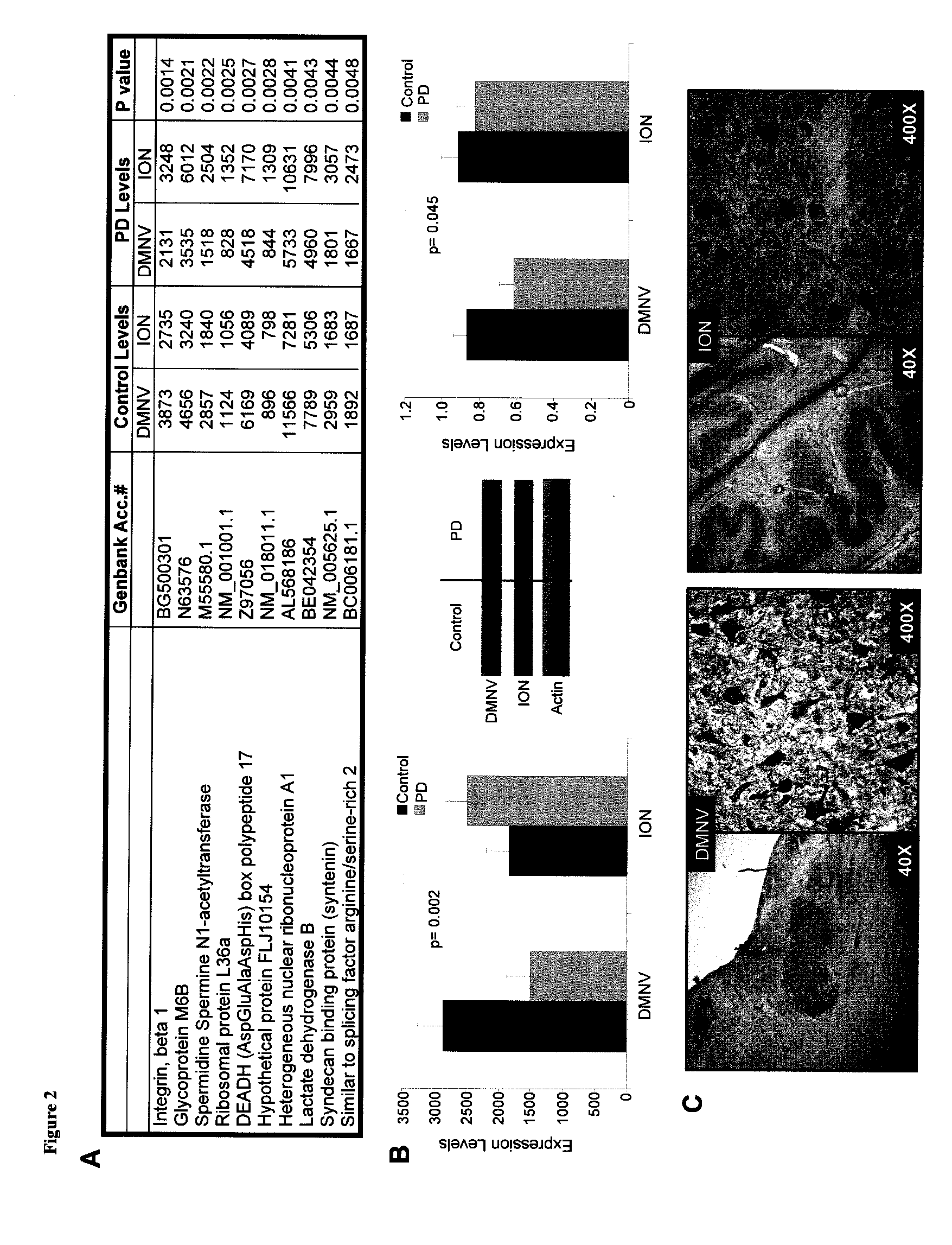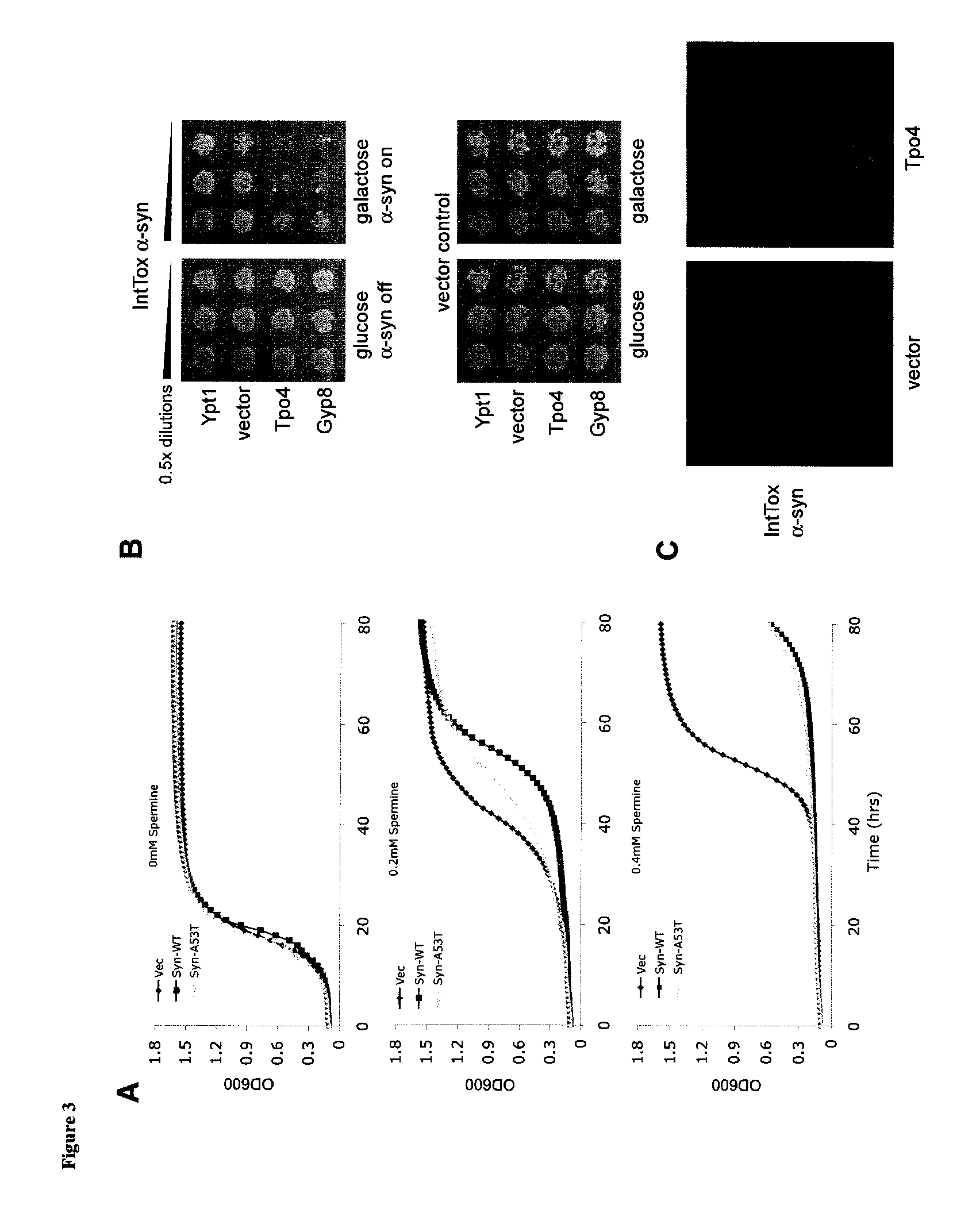Polyamine inhibitors for the treatment and prevention of parkinson's disease
a technology of polyamine inhibitors and parkinson's disease, which is applied in the direction of biocide, drug composition, peptide/protein ingredients, etc., can solve the problems of confounding the interpretation of gene-expression studies and presenting a number of analytic challenges in the brain, so as to reduce the amount of -synucleic aggregation, reduce -synucleic aggregation, and reduce the amount of -
- Summary
- Abstract
- Description
- Claims
- Application Information
AI Technical Summary
Benefits of technology
Problems solved by technology
Method used
Image
Examples
example 1
Functional Imaging Identifies Brainstem Regions Targeted by and Resistant to Parkinson's Disease
Materials and Methods:
Brain Imaging Studies
[0109]Subjects: Subjects were recruited from a cohort of patients seen and rated by Dr. Lucien Coté at Columbia University Medical Center, Department of Neurology. At the time of the scan all patients were in early stages, rated at stage 1 or 2 according to the clinical criteria outlined in Hoehn and Yahr's Staging of Parkinson's Disease, Unified Parkinson Disease Rating Scale (UPDRS). Age matched subjects were acquired for the control group. Two of five PD and three of five controls were women. All controls underwent a neurological evaluation prior to the scans to assure their “control” status.
[0110]Data acquisition and processing: Subjects were imaged with a 1.5 tesla scanner Philips Intera scanner following a similar protocol as described (Lin, W. at al. 1999 and Moreno, H. et al. 2007). For each subject, 2 sets of oblique axial 3D T1-weighted...
example two
Yeast Studies Establish a Link Between Polyamines and A-Synuclein Toxicity
Materials and Methods:
Yeast Studies
[0133]Yeast Strains and Media: All yeast studies used the W303 strain (MATa ade2-1 can1-100 his3-11,15 leu2-3112,trp1-1, ura3-1). The α-synuclein (α-syn) strains used for growth rate assays were as follows: a control strain, containing an empty vector (pRS304) at the TRP1 locus, a strain expressing wildtype human α-synuclein fused to GFP at the TRP1 locus (pRS304Gal-α-SynWT-GFP), and a strain expressing human α-synuclein (A53T)-GFP fusion protein at the TRP1 locus (pRS304Gal-α-SynA53T-GFP). The α-syn overexpressing yeast strain used for Tpo4 characterization was W303 with α-syn integrated into HIS3 and TRP1 loci (IntTox): pRS303Gal-αSynWT-YFP pRS304Gal-αSynWT-YFP. Strains were manipulated and media prepared using standard techniques. The A53T mutation enhances the toxicity of α-synuclein both in vitro (Conway, K. A. et al. 1998) and in yeast (Outeiro, T. F. et al. 2003), and ...
example three
Mice Studies Establish a Link Between SAT1 Activity and A-Synuclein Histopathology
Materials and Methods:
Transgenic Mice Studies
[0142]α-Synuclein transgenic mice and infusion: For this study, heterozygous transgenic (tg) mice (Line 61) expressing wildtype human α-synuclein (hα-syn) under the regulatory control of the mThy1 promoter were used (Rockenstein, E. et al. 2002). These animals were selected because they display abnormal accumulation of detergent-insoluble hα-syn and develop hα-syn-immunoreactive inclusion like structures in the basal ganglia, cortex, and limbic system (Rockentein, E. et al. 2002). Furthermore, these animals also display neurodegenerative and motor deficits that mimic certain aspects of PD and Dementia with Lewy bodies (Fleming, S. et al. 2004). Infusions were performed as previously described (Veinbergs, I. et al. 2001). In order to evaluate the effects of the polyamine pathway, hα-syn tg mice (10-11 months old) received intraventricular infusions with a can...
PUM
| Property | Measurement | Unit |
|---|---|---|
| thickness | aaaaa | aaaaa |
| pH | aaaaa | aaaaa |
| real time- | aaaaa | aaaaa |
Abstract
Description
Claims
Application Information
 Login to View More
Login to View More - R&D
- Intellectual Property
- Life Sciences
- Materials
- Tech Scout
- Unparalleled Data Quality
- Higher Quality Content
- 60% Fewer Hallucinations
Browse by: Latest US Patents, China's latest patents, Technical Efficacy Thesaurus, Application Domain, Technology Topic, Popular Technical Reports.
© 2025 PatSnap. All rights reserved.Legal|Privacy policy|Modern Slavery Act Transparency Statement|Sitemap|About US| Contact US: help@patsnap.com



